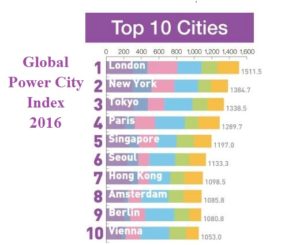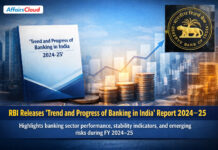According to the 2016 Global Power City Index (GPCI) report, London has topped for the fifth consecutive year with Mumbai ranked 39th on the list of the world’s leading global cities for business, innovation and culture.
About the Index,
The 2016 Global Power City Index (GPCI) report was released by the Mori Memorial Foundations Institute for Urban Strategies, ranked London as the leading overall city, highlighting the capitals strong cultural offering, ease of doing business and global transport links.
- The Japan-based Mori Memorial Foundation’s Institute for Urban Strategies has published its GPCI report annually since 2008. The GPCI index is based on an evaluation of 70 criteria, analysing the strengths and weaknesses of global cities amid intensifying competition.

- The report ranks 42 major cities of the world across six key measures of economy, research and development, culture, accessibility, environment and livability.
- London performed well across all areas, retaining its top spot for the fifth year in a row and ranking above other cities such as New York, Tokyo and Paris. The UK capital was first awarded the leading position in 2012, the year it successfully hosted the Olympic and Paralympic Games.
- New York experienced no significant change in its ratings, retaining its No. 2 slot.
- Tokyo overtook Paris and moved into third place. The increase was due to a number of factors, including a reduction in Japan’s rate of corporate taxation, an increase in the number of visitors to the city from abroad and an increase in the number of direct flight connections to overseas destinations. Singapore completes the top 5 cities in the annual ranking.
- It is noted that Mumbai is the only Indian city to feature on the index, was ranked 39th.
About London :
London is the capital and most populous city of England and the United Kingdom. Standing on the River Thames in the south east of the island of Great Britain, London has been a major settlement for two millennia.
- It was founded by the Romans, who named it Londinium. London’s ancient core, the City of London, largely retains its 1.12-square-mile (2.9 km2) medieval boundaries.
- Since at least the 19th century, “London” has also referred to the metropolis around this core, historically split between Middlesex, Essex, Surrey, Kent, and Hertford shire, which today largely makes up Greater London, governed by the Mayor of London and the London Assembly.
- London is a leading global city, in the arts, commerce, education, entertainment, fashion, finance, healthcare, media, professional services, research and development, tourism, and transport. It is one of the world’s leading financial centres and has the fifth- or sixth-largest metropolitan area GDP in the world. London is a world cultural capital.
- It is the world’s most-visited city as measured by international arrivalsand has the world’s largest city airport system measured by passenger traffic. London is the world’s leading investment destination, hosting more international retailers and ultra high-net-worth individuals than any other city.
London’s universities form the largest concentration of higher education institutes in Europe, and a 2014 report placed it first in the world university rankings. According to the report London also ranks first in the world in software, multimedia development and design, and shares first position in technology






